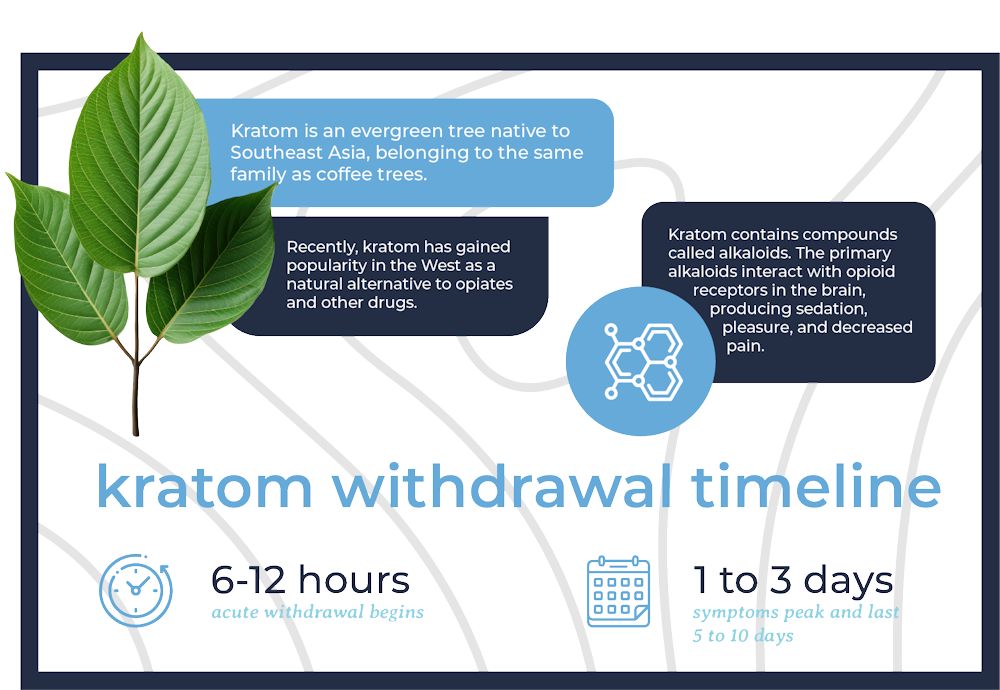Kratom has an online reputation of being a safe alternative to manmade opioids. That’s incorrect. Rather, the substance has addictive properties that can lead to unpleasant withdrawal symptoms. In this blog, we’ll discuss what a typical kratom withdrawal timeline looks like.
Do you need to know more about Kratom withdrawal symptoms? Call us today at 866.262.0531.
Who Takes Kratom?
Kratom is an evergreen tree native to Southeast Asia, belonging to the same family as coffee trees. It has been used in traditional medicine for centuries, with effects ranging from stimulation and relaxation to pain relief and improved sleep patterns. Recently, kratom has gained popularity in the West as a natural alternative to opiates and other drugs.
Kratom is available in various forms, from powder and capsules to tea and extracts. It can be taken as a supplement or enjoyed as a beverage. Kratom has both energizing and sedative effects, depending on the strain and dosage. The leaves of the kratom tree contain compounds called alkaloids, which interact with the body’s receptors to produce various effects.
A friend might have turned you on to this herbal substance as a way to boost energy. Maybe you’re dealing with pain and want an alternative to prescription pain pills. Because you can drink the herb as a tea, it’s easy to incorporate with a meal. Somehow, it seems like it’s healthy.
Kratom is becoming increasingly popular with people from all walks of life. It’s not just the health-minded looking for an alternative. Athletes, working professionals, and students have embraced kratom as a way to help them through the day. However, kratom isn’t a consequence-free substance. It carries some risks, including possible addiction and overdose.
A Closer Look at the Kratom Withdrawal Timeline

The fact that there’s a kratom withdrawal timeline proves that this substance isn’t as benign as you might have thought. You start out with mood swings that make you feel sudden bouts of deep depression. Like a pendulum, your mood swings from depression to feeling okay. It’s difficult for others to relate to you.
Withdrawal symptoms also include anger management problems that worsen over time. You feel irritable and act out aggressively. As cravings get worse, your anger increases. It’s now impossible to become a danger to others at this time.
Withdrawal starts a couple of hours after your last dose. Symptoms worsen over the next couple of days. Similarly, your emotional and psychological responses deteriorate. Typical kratom withdrawal lasts about five to seven days.
Overcoming an Addiction to Kratom
Don’t be fooled by the suggestion that herbs are safe. Participation in a kratom addiction treatment program shows you that it’s a lot like overcoming an opioid dependency. Typical therapeutic interventions include:
- Dual diagnosis treatment for program participants with co-occurring psychiatric disorders
- Trauma therapy that benefits people with unresolved situations from the past, which create unwelcome thoughts and feelings
- Behavioral therapies as a means for making changes to dysfunctional patterns
- Group therapy that encourages peer support and sets the tone for experiential therapy opportunities
- One-on-one talk therapy sessions that allow for goal-setting and skills development for long-term sobriety
During rehab, you learn about the kratom withdrawal timeline and post-acute withdrawal syndrome. It can happen to someone with opioid dependency. You may have recurring feelings of anger, cravings, and depression. Most importantly, you may feel that returning to kratom abuse is the only way to stop these sensations.
That’s not true. For starters, post-acute withdrawal only happens intermittently—if at all. Secondly, it’ll be a short-lived occurrence. However, don’t be afraid to check in with a therapist if you feel like things are getting out of control.
Seek Help Today
For severe cases of kratom dependency, inpatient care is your best option. You live at the facility and undergo immersive care. After therapy, you interact with peers who are also in recovery. Doing so is instrumental in helping you to relate to others when not using.
If necessary, consider an extended stay. That said, you might be an excellent candidate for a partial hospitalization, which lets you return home at night. Intensive outpatient treatment gives you a chance to schedule your therapy around other obligations.
Now that you know about the kratom withdrawal timeline, find out how to end your addiction for good. Contact Crestview Recovery.

Since 2016, Dr. Merle Williamson, a graduate of Oregon Health Sciences University, has been the Medical Director at Crestview Recovery, bringing a rich background in addiction medicine from his time at Hazelden Treatment Center. He oversees outpatient drug and alcohol treatments, providing medical care, setting policies, detox protocols, and quality assurance measures. Before specializing in addiction medicine, he spent 25 years in anesthesiology, serving as Chair of Hospital Pharmacy and Therapeutics Committee and Chief of Anesthesia at Kaiser Permanente. This experience gives him a unique perspective on treating prescription drug addiction.






